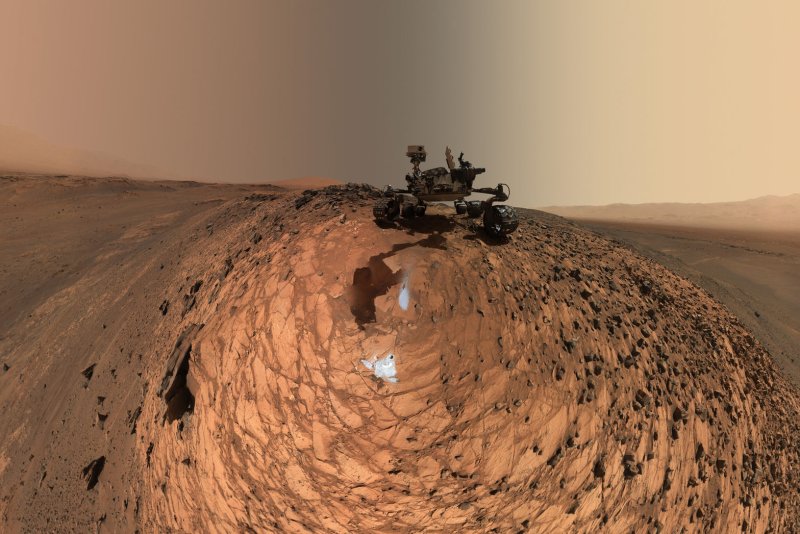A selfie image captured using Curiosity's Mars Hand Lens Imager shows the rover ascending Mount Sharp in 2015. Photo by NASA/UPI |
License Photo
Feb. 1 (UPI) -- Scientists were able to map Mars' gravity by repurposing data collected by the Curiosity rover's navigational sensors.
After realizing Curiosity's accelerometers can be used like gravimeters when the rover is at a standstill, scientists surveyed navigational data collected during the mission's first five years. Researchers were able to plot changes in the Red Planet's gravity along the path the rover took as it ascended Mount Sharp.
The new gravity data allowed scientists to estimate the density of the underlying rock along the rover's route. Gravity is weaker on the slopes of Mount Sharp than scientists expected, suggesting the sedimentary rock that forms the mountain isn't all that dense.
"The lower levels of Mount Sharp are surprisingly porous," Kevin Lewis of Johns Hopkins University said in a news release. "We know the bottom layers of the mountain were buried over time. That compacts them, making them denser. But this finding suggests they weren't buried by as much material as we thought."
Martian probes have previously mapped Mars' gravity fields, but not with the precision offered by super sensitive on-the-ground instruments. After calibrating the rover's data -- accounting for the influence of temperature and the rover's shifting axis tilt on Mount Sharp's uneven terrain -- scientists compared the improvised gravimeter observations with gravity field maps. The data was in agreement.
Mount Sharp rises 18,000 feet from the bottom of Gale Crater, an impact crater formed by a meteor that struck Mars between 3.5 billion and 3.8 billion years ago. Scientists are still unsure how exactly Mount Sharp formed, but the latest data -- published in the journal Science -- suggests at least one popular theory is flawed.
Some scientist hypothesize the crater was once completely filled with sediment. Over time, wind eroded large amounts of sediment, leaving behind Mount Sharp. But all that heavy sediment would have compacted the bottom layers of Mount Sharp.
"The low density of rocks in Gale Crater suggests that they did not undergo deep burial," said Nicholas Schmerr, an assistant professor of geology at the University of Maryland. "This could mean that Mount Sharp was not excavated by erosion, but rather was constructed by wind deposition and other processes."















